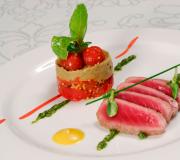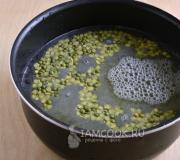How to draw loose snow. Master class “How to draw snow without whitewash”
Maria Gorbacheva
For such Master class we will need the following materials: -
Thick sheet of white paper,
Simple pencil,
Paints - gouache for children's creativity,
Brush No. 3,
Cocktail tube.
1. Preliminary drawing made in pencil - a snowy mountain and a village on the horizon.
2. Paint the sky with black, purple, blue or cyan paint. The color of the sky will determine the time of day in the drawing. (night, evening or morning). We leave the wooden houses colorless for further painting.

3. Brown paint draw logs on the house and fences - and the windows are painted yellow (turn on the light).

4. Green paint on wavy line horizon, in several places can be indicated with the help of a few brush strokes - a fir-tree and pine forest.

5. Blotography - a long-familiar technique - when from an inflated blot with the help of an additional drawing details, you can recognize the image. For further work we need black paint and a small amount of water. (mix water and paint in a container)- using a brush No. 3, we apply the watery trunks of the bush and, using a cocktail tube, we blow up the small branches. We blow strongly and sharply into the tube and direct our drop in different directions, now to the right, now to the left.

6. With the help of several applications of the brush, the drawing can be supplemented by a flock of birds that have flown in to rest or peck the remaining seeds.

7. We put our birds on branches and let them walk around snow.

8. Mix white and blue paint for blue flakes snow.
We dip a brush stick into the blue paint and begin to merrily knock on the entire surface of the sheet - let the snow fall on the houses, the bush, and the birds. Children get a little emotional release from the cheerful knocking and the drawing is ready when the blue flakes snow covers the entire leaf.

I wish my colleagues creative success!
You will need:
- graphics editor
(Photoshop or Open Canvas are ideal, although other programs can also be used)
- Graphics tablet
(or mouse... remember, if you use a mouse for work, it will be much more difficult)
STEP 1
Open a new file in your program (Photoshop, Open Canvas, etc.). The file can be any size, we're just practicing for now. Create a new layer and fill it with one color using the Bucket tool. Take the color light gray-blue.
Left: It's just nonsense.
On right: I put a little dark color on top. I simply applied the paint using a huge airbrush with an Opacity of 50%. You can use a gradient if you want. Or, if you want to do the same as me, repeat after me. Although I like my choice better.
STEP 2
Create a new layer. On this layer, using a regular soft round brush (changing sizes), I apply spots that imitate falling snow. Make sure the snow doesn't fall in even rows, if you know what I mean. Also, you need to make sure that they are not perfectly round. Try to create a more “natural” snow; for this, do not use pure white, but rather use a very light gray.

STEP 3
Use Blur... yes, just blur all the snow you just painted.

This is to show that the snow is in the background.
STEP 4
Create another layer and repeat the previous steps.

This way we get a deeper picture.
STEP 5
After that I decided to go back to the background layer and add a little more color. You can skip this step, it’s all at your discretion.
So, I took a large airbrush and applied blue-green color at the top of the design, and white at the bottom. See how it happened?!
I also slightly adjusted the Opacity of the two snow flake layers.

STEP 6
Using (again) a soft airbrush, add some “cool air” with a few loose brush strokes.
Painting snow, and even in watercolors, is often a difficult task for beginners. But we will help! Let's reveal a few secrets.
Masking fluid.
This liquid will help you recreate a natural, voluminous winter sky. Masking fluid is a viscous, translucent substance that can be used to cover certain parts of the design - those in this moment you don't want to paint over. When applied it is wet, and when dried it acquires a slightly sticky consistency. The "masked" areas will not be affected by the paint, even if you paint over a layer of masking agent.
Using this substance not only helps to get rid of dirt in your work, but also magically eliminates the need to write snow: just peel off what is pasted, and - voila! - snow will appear in your picture.
Let's illustrate this with an example. Let's say you have some ink and want to draw a picture of falling snow. How to do it?
First method: You can simply put dots on the sheet that imitate falling snowflakes. The advantages of this method are simplicity and control over the brush. The downside is that the look will be quite decorative, and it won't suit every job.
Second method, “tapping”: dip the brush in the masking liquid, move it over the sheet and, moving your hand, shake off droplets of liquid onto the canvas with careful taps. There is a little less control here, but the appearance of “snowflakes” will be more natural.
Third method, with a toothbrush: take an old one toothbrush and dip it in masking fluid. Now use your finger to gently pull and release the fibers above the sheet, causing liquid to splash onto it. This method of control has the least risk of going overboard and messing up, but the result is completely unique and natural.
Result
By selecting suitable way, apply masking fluid with it, and then get to work. It doesn’t matter what you work with: watercolor or ink. When finished, dry it and then simply remove the masking pieces. Here comes the snow!
Did you succeed? Write in the comments!
Snow outside the window is a great reason to pick up a brush and depict all the beauty of winter. Show your kids several ways to draw snowdrifts, “crystal” trees, “horned” snowflakes, fluffy animals, and let winter “drawing games” bring the joy of creativity and decorate your home.
Music to which masterpieces are created
So, let's turn on some pleasant background music and... draw winter with the children!
Drawing with “snow”

mtdata.ru
You can imitate snow in a drawing in different ways.
Option No. 1. Draw with PVA glue and semolina. Squeeze out the required amount of glue directly from the tube; if necessary, you can spread it with a brush (if you plan to cover large surfaces). Sprinkle the image with semolina. After drying, shake off excess cereal.

www.babyblog.ru
Option No. 2. Paint with salt and flour. Mix 1/2 cup of water with 1/2 cup of salt and the same amount of flour. Mix the “snow” well and draw winter!

www.bebinka.ru
Option number 3. Draw with toothpaste. Toothpaste perfectly serves as “snow” in the drawings. It can be tinted with watercolor or gouache if you need to get a color image.

Drawings with white paste on dark paper look beautiful. And they SMELL delicious!

The greatest popularity toothpaste It probably won because it washes off easily, so you can paint with the paste on glass. Feel free to pick up the tubes and go decorate mirrors, windows and other glass surfaces in your home!
 polonsil.ru
polonsil.ru
Option No. 4. Draw with shaving foam. If you mix PVA glue with shaving foam (in equal proportion), you will get an excellent “snowy” paint.

www.kokokokids.ru
Option #5. Painting with salt. If you pour salt onto a pattern outlined with PVA glue, you will get a sparkling snowball.
Drawing on crumpled paper
An unusual effect can be achieved if you draw on previously crumpled paper. The paint will remain in the creases and form something like crackle.
Drawing with stencils

img4.searchmasterclass.net
Stencils make the drawing process easier for those who “don’t know how” (as it seems to them). If you use several stencils at the same time, you can get an unexpected effect.

mtdata.ru
By leaving the part of the image covered with the stencil unpainted, you can pay more attention to the background: sprinkle salt on the still wet surface, apply strokes in different directions with a hard brush, etc. Experiment!
 www.pics.ru
www.pics.ru
Several sequentially applied stencils and sprays. It is convenient to use an old toothbrush or a stiff bristle brush for these purposes.

www.liveinternet.ru
A knitted snowflake will help you create real lace on paper. Any thick paint will do: gouache, acrylic. You can use a spray can (spray from a short distance strictly vertically).
Drawing with wax

Drawings drawn with wax look unusual. Using a regular (not colored) candle, we draw a winter landscape, and then cover the sheet dark paint. The image “appears” right before your eyes!
Who are you? Seal?

masterpodelok.com
The effect of fluffy wool can be created by a simple technique: dip a flat brush in thick paint (gouache) and apply strokes with a “poke”. Drawings with white paint always look better on a dark, contrasting background. For winter motifs All shades of blue are great.
How to draw winter trees

www.o-detstve.ru
The crowns of these trees are made using a plastic bag. Dip in paint and blot in in the right places- that’s the whole secret of “snow caps” for trees.

cs311120.vk.me
Finger painting is great for kids. Dip your index finger in thick gouache and generously sprinkle snow on the branches!
 masterpodelok.com
masterpodelok.com
Unusually beautiful snow-covered trees are obtained using cabbage leaves. Cover the sheet with white gouache Chinese cabbage- and voila! This painting looks especially impressive against a colored background.
 www.mtdesign.ru
www.mtdesign.ru
No cabbage - no problem. Any leaves with pronounced veins will do. You can even sacrifice your favorite ficus. The only BUT, remember that the juice of many plants is poisonous! Make sure your child doesn’t taste his new “brush.”

ua.teddyclub.org
The trunk is a handprint. And everything else is a matter of minutes.

www.maam.ru

orangefrog.ru
A favorite technique for many is blowing paint through a tube. We create “snowiness” using the little artist’s fingerprints.
 www.blogimam.com
www.blogimam.com
Not everyone will guess how this charming Birch Grove. The resourceful artist used masking tape! Cut strips of the required width and glue them onto a white sheet. Paint over the background and remove the paint. Draw the characteristic “dashes” so that the birch trees become recognizable. The moon is made in the same way. Thick paper is suitable for these purposes; the tape should not be too sticky so as not to damage the top layer of the design.
Drawing with bubble wrap
 mtdata.ru
mtdata.ru
Apply to bubble wrap white paint and apply it to the finished drawing. It's snowing!
 mtdata.ru
mtdata.ru
The same technique can be used in applications.
The snowman has melted. It's a pity…

mtdata.ru
This idea is suitable for both young artists, and for those who want to give a gift “with humor.” Cut out “spare parts” for the snowman from colored paper in advance: nose, eyes, hat, twig arms, etc. Draw a melted puddle, wait for the paint to dry and glue what’s left of the poor fellow snowman. Such a drawing could become a great gift loved ones on behalf of the baby. More more ideas in our article.
Drawing with palms

www.kokokokids.ru
A simple way to create a surprisingly touching New Year's card- is to tell a story about funny snowmen. You can create a whole family if, based on a palm print, you add carrot noses, coal eyes, bright scarves, buttons, twig hands, and hats to your fingers.
What's there outside the window?

ic.pics.livejournal.com
What does the window look like from the street side? Unusual! Invite your child to look at the window through the eyes of Santa Claus or another character who may find himself outside in the most severe cold.
Dear readers! Surely you have your own “winter” drawing techniques. Tell us about them in the comments.
Snow rarely falls in the part of Devon where I live and paint. When this happens I always stop whatever I'm doing in the studio and take the opportunity to paint it, just like when I arrived on Dartmoor two years ago. With an overcast sky, the scene that greeted my eyes on this unusual day was more of an over-lit, dull landscape with little contrast. Just when I started to think that this day might be a disappointment, the clouds dissolved and the forest was filled with light. Contrast increased, shadows added interesting details foreground, and snow-covered areas stood out clearly in the distance.
It's time to do some quick pencil sketches and carefully consider color features before heading back to the studio. For some artists, painting snow in watercolor means leaving the paper or canvas unpainted. However, the color of snow is not simply "white" and requires subtle processing with a wide range of colors for maximum effect. Snow often reflects colors in the sky, and the shadows cast are worth a closer look. Indeed, when I paint snowy landscapes, I'm always surprised at how little paper I leave uncolored.
Original photoArt materials
Watercolor paints:
- French Ultramarine
- Permanent Rose
- Raw Sienna
- Burnt Sienna
- Herbal Greens (Sap Green)
- Winsor Blue Green Shade
- Neutral Tint
- Transparent Oxide Brown
- Permanent White or white gouache
Other:
- Nice pointed nylon stack
- Sable brushes (sizes 6, 10 and 12), serrated brush, size 2
- Bockingford sheet 300gsm, NOT watercolor paper
- 2B pencil
- Masking fluid
- Kitchen roller
Step 1

Stretch out a sheet of watercolor paper on an easel. Use a 2B pencil to sketch out the key elements of the landscape. Save the lightest areas of the snow with masking fluid. Use a fine nylon brush or a small pointed stick. Remember that the smears left by the masking fluid when it is removed will be white, so think carefully about their placement and role within the project at this stage. Let the paint dry completely.
Step 2

Wet the sky area clean water. Hold your easel at an angle of about 20 degrees and use a large brush (size 10 or 12) to apply a mixture of French Ultramarine and Permanent Rose to the left, then apply Natural Sienna across and finally use Winsor's Blue-Green Shade for the brightest part sky on the right. Allow the mixture of colors to create soft, "lost" edges. This will create a contrast to the sharper, more defined edges in much of the landscape.
Once the sky area is dry, start adding some loose, distant landscape details with blends of the colors used in the sky with the addition of Grassy Greens and Neutral Tint for the most distant hills. See how you can use a dry brush to let white color paper to show through the implied snow.
Step 3

Keep the paper straight. With a mixture of French Ultramarine, Permanent Pink and Winsor Blue, paint the shadow cast by the wall. Please pay Special attention to the right edge: the shadows should “sit” exactly at the level of the earth’s surface, describing the angle at which the earth is located. The selected compound will granulate, add graininess and a richer structure to the snow. Within the darkened area, add more concentrated mixtures of blue and purple shades to add some flair.
Step 4

The dark granite wall provides significant contrast mainly in light painting. Paint it with varied blends of French Ultramarine and Burnt Sienna or French Ultramarine and Transparent Oxide Brown. Create structure by adding darker mixtures to the stones as if they were dry, but don't do this where it fades into the background as it will distract the eye.
Step 5

With a good sable brush (size 6), start adding structure and detail to the distant hills. Use mixtures of French Ultramarine with Oxide Brown, Natural Sienna with Burnt Sienna, and Grass Greens with French Ultramarine to paint into trees and shrubs. Keep your brush very dry and add some snow texture to the area above the main wall.
Be careful not to make the tones of distant details too strong. Select some of secluded corners and cracks in the wall and use French Ultramarine with Neutral Tint.
Step 6

Remove masking fluid. With the same mixture of French Ultramarine and Permanent Pink used for the shadow of the wall painted in the snow on the tops, leave a few unpainted areas for the brightly lit areas. Notice the rounded, dark edges of the snow to indicate its depth.
For the posts, use a mixture of French Ultramarine and Transparent Oxide Brown, as well as for the twigs and grass stems that are pushing out from under the snow. Use a damp brush to soften some of the shadowed areas.
Finally, add some white gouache to the sides and tops of the pillars, and add some snowflakes if you feel the need.




